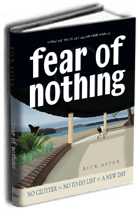The book Fear of Nothing makes the bold promise of “no clutter” and “no to-do list.” This promise is only half as big as it appears. That’s because you probably don’t have both clutter and a to-do list at the same time, even though it sometimes appears that you do.
It is virtually impossible to be living with clutter and work your way through a to-do list. If you have enough clutter that it gets in the way sometimes, then your to-do list can’t proceed the way it’s intended. With clutter, a to-do list is little more than wishful thinking. Conversely, if you have a to-do list and work through it item by item, that means you didn’t run into much clutter along the way. If a to-do list is effective, it shows that you have been able to remove yourself from clutter, at least for the day.
A to-do list can’t work in the presence of clutter because of one of the core assumptions of a to-do list. That assumption is that it is possible to go off and work on just one thing. It is an assumption that holds only if you have a well-ordered work environment — perhaps a clean desk, a fully stocked kitchen, or a conference room with a closed door. This illusion of a single task in isolation breaks down immediately when you venture out into the wild — into a house, a business office, or any place that isn’t so tightly controlled. I’ll tell you a story to illustrate this.
A few days ago I saw the movie Moldy, which shows the effects of mold toxins from water-damaged buildings on ordinary people’s health. The movie made me want to keep a cleaner house, to reduce the risk of mold. One of the first things I knew I wanted to do was clean the rain gutters. Well-functioning rain gutters at the edge of a roof carry water away quickly when it rains, reducing the chance that water stays with the house after the storm is over. Water that goes into a house, of course, can lead to the growth of mold. If this were a to-do list, my task would be, “Clean the rain gutters.” It was Saturday morning, so it was my chance to work on this task.
I got the ladder out and removed leaves and twigs from the rain gutters, tossing them to the ground below. In the most narrow understanding of my task, the task was complete — but it wasn’t really. It wasn’t my intention to leave debris on the lawn and sidewalk. I am not eager to say how much debris there was. Suffice it to say that a seven-month gap between cleaning is perhaps a little too long. I would have to take a few minutes to clean up the ground.
This already violates the to-do list assumption of a single task. Even when everything goes smoothly, there are very few single tasks. One task implies another, which implies another. Cleaning the rain gutters implies cleaning up the resulting mess. I went to get my shovel.
On the way up the hill to the compost heap with the first shovelful, I found that my way was blocked by a poison ivy vine that had grown out over the path during the previous week. I am not the devil-may-care kind of person who would tromp right through a patch of poison ivy. I would have to stop what I was doing and go get other tools to remove the poison ivy before I could proceed safely with my cleanup task.
While we’re here, consider this: the gutter-cleaning task led me to the poison ivy task precisely because I was not working in a well-ordered, tightly controlled work environment. In theory, if I had spent an extra few days on the grounds during the spring, I could found the poison ivy growing near my path and nipped it in the bud before it became an obstacle. It is that kind of dedicated focus and detailed day-to-day management that is required to create the well-ordered environment that theories of time management require. In practice, anyone who is catching up with a lawn during the spring season in Pennsylvania will find that it defies all attempts to keep it under such tight control during these three months of the year.
Notice too how much could had gone wrong if I had been slowed down by clutter. At the point where I am clipping away the new poison ivy vine, I am already six levels deep in tasks leading to other tasks. I am using tools I did not necessarily think about in advance. If I were less well organized, I could have found clutter blocking the way when I went to get the ladder or the shovel, or I might have had to spend an extended period of time just finding the clippers and gloves. You ordinarily wouldn’t write down the separate task of finding a tool on a to-do list. You assume your tools are at hand. In a cluttered place, though, that assumption may not be correct. When you are first trying to create order in your life, you can be delayed by disorder and unexpected difficulties in one sub-task after another, which can make the simplest task seem almost out of reach.
If you sometimes feel like life is too hard, but you aren’t sure where the obstacles are, try this: act as if there were no obstacles. Do this just for a minute or two. You will encounter obstacles almost right away. Perhaps, like me, you are inspired to clean the rain gutters, and within a minute, you are asking, “Why don’t I have the right kind of ladder for this task?” or “Where is my ladder?” or “What is all this stuff hanging from the ladder?” Or perhaps you have the ladder but you aren’t wearing the right shoes. You could have the first ten steps go smoothly only to hit your obstacle on the eleventh. To cite another example, maybe you want to buy groceries but you need to clear space in the refrigerator or the back seat of the car. It is important not to be discouraged when you discover obstacles in this way. It is your intention to discover the obstacles so that you can address them, so that you can go farther the next time.
With clutter, you are surrounded by obstacles, so that every task turns into five, ten, even twenty unplanned tasks, which at times may seem to be spiraling out of control. These added task are not only unexpected obstacles, but also include other things you notice along the way. Almost as soon as I picked up the shovel this morning, I noticed cobwebs on my house, and I used the shovel to clear them. Clearing cobwebs probably would not have been a task on my to-do list, but it was the obvious thing to do while I happened to be right there with a tool that would reach them.
A to-do list doesn’t do justice to your situation when every task has the potential to spawn two or three more tasks, which in turn can generate more. If you work from a to-do list in the uncontrolled real world, it can’t be a surprise to get to the end of the day and find that you have only completed task 1 on the list. Conversely, you might be just as productive proceeding without a list to guide you. Regardless of what you think you are working on, you will come upon the same obstacles. Realizing this, it helps not to take a to-do list too literally. You can think of the to-do list, or the clutter for that matter, as merely a guide to the obstacles that await you — and the opportunities to be found on the other side of those obstacles.
Think back to the original inspiration for my work this morning. I decided I would improve my health (and the health of everyone else who might be around) by having a cleaner house. The cobwebs and poison ivy that I discovered along the way were not random obstacles preventing me from working on my goal. Removing poison ivy and cobwebs contributed to the same goal I started out with. I will go back and finish cleaning the sidewalk now, and then if I decide I want to continue working toward a cleaner house, I am sure I can easily find more to do.



No comments:
Post a Comment